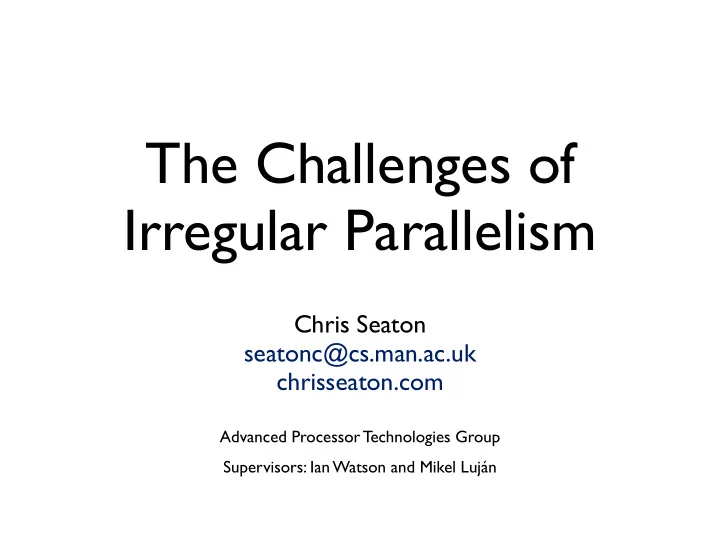

The Challenges of Irregular Parallelism Chris Seaton seatonc@cs.man.ac.uk chrisseaton.com Advanced Processor Technologies Group Supervisors: Ian Watson and Mikel Luján
Why should I write parallel programs?
CPU
CPU CPU
H. Stutter. The free lunch is over – a fundamental turn toward concurrency in software. Dr. Dobb’s, 30(3), 2005.
Core Core
Core Core Core Core
Core Core Core Core Core Core Core Core Core Core Core Core Core Core Core Core
We already know how to make parallel programs
Structure your program so that there are tasks that can run at the same time
Time
Time
Matrix A multiplication B C a b c aA + bB + cC
Matrix D multiplication E F a b c aD + bE + cF
Matrix multiplication
Matrix multiplication Time
However, this only works if those tasks are entirely independent of each other
Time
Some kind of shared object - choke point Time
Ideally don’t write software with shared objects that cause choke points
Photo courtesy of Argonne National Laboratory.
Let’s look at a tricky problem
The entire board is one big shared object Time
We’re calling this an irregular problem - we can’t divide up the shared resource before the tasks start
“It's easier to ask forgiveness than it is to get permission.” This photograph is a work of a sailor or employee of the U.S. Navy, taken or made during the course of the person's official duties. As a work of the U.S. federal government, the image is in the public domain.
We’ll assume that tasks will not get in each other’s way If they do, we’ll sort it out when it happens
Time
Time
Time
A little more time
Two questions: How can you tell when one task gets in the way of another? How can you cancel a task that has already been running?
Transactional memory Instead of writing to memory, write to a log You can tell if two tasks are getting in each other’s way by comparing their logs You can cancel a task by throwing the log away
0x80d2ef52 0xecb10c62 0x4ee47f35 0xbae0a866 0xd6b4eba9 0xe4c2615d 0x2c86d524 0x61639ad5 0xe617f31d 0xe617f31d 0x40578fff 0x6a8bdcf3 0x9bb7febc 0xe9e88989 0x4ddc0e5f 0x8fbcf724 0xbd660807 0x095b76c0
0x80d2ef52 0xecb10c62 0x4ee47f35 0xbae0a866 0xd6b4eba9 0xe4c2615d 0x2c86d524 0x61639ad5 0xe617f31d 0xe617f31d 0x40578fff 0x6a8bdcf3 0x9bb7febc 0xe9e88989 0x4ddc0e5f 0x8fbcf724 0xbd660807 0x095b76c0
0x80d2ef52 0xecb10c62 0x4ee47f35 0xbae0a866 0xd6b4eba9 0xe4c2615d 0x2c86d524 0x61639ad5 0xe617f31d 0xe617f31d 0x40578fff 0x6a8bdcf3 0x9bb7febc 0xe9e88989 0x4ddc0e5f 0x8fbcf724 0xbd660807 0x095b76c0 Actually write to memory
0x80d2ef52 0x124683b3 0x4ee47f35 0x60f005b2 0xd6b4eba9 0x831327fa 0x2c86d524 0xf69d8cf9 0xe617f31d 0x9ea7c8df 0x40578fff 0x61f43a4a 0x9bb7febc 0x170c4b44 0x4ddc0e5f 0x7778a6aa 0xbd660807 0x73068a29
0x80d2ef52 0x124683b3 0x4ee47f35 0x60f005b2 0xd6b4eba9 0x831327fa 0x2c86d524 0xf69d8cf9 0xe617f31d 0x9ea7c8df 0x40578fff 0x61f43a4a 0x9bb7febc 0x170c4b44 0x4ddc0e5f 0x7778a6aa 0xbd660807 0x73068a29 Actually write to memory Actually write to memory
Transactional memory is moving from research to production C, C++, Java, Scala, Clojure, Haskell
There are other techniques for reversing computation If you know you added x to a value, subtract x . If you know you added a node to a graph, remove it. The Jefferson Time Warp System from the mid-80s - send anti-messages over networks.
Do we have a solution?
Transactional memory can be slow The hardware is probably limited Not the magic bullet some hoped Optimistic execution in general can be wasteful
Irregular problems are the billion dollar problems Physical meshes Web and social graphs Machine learning networks Data mining [1] [1] J. Tournois, C. Wormser, P . Alliez, and M. Desbrun. Interleaving Delaunay refinement and optimization for practical isotropic tetrahedron mesh generation . Technical Report 6826, INRIA, 2009.
Chris Seaton seatonc@cs.man.ac.uk chrisseaton.com
Recommend
More recommend